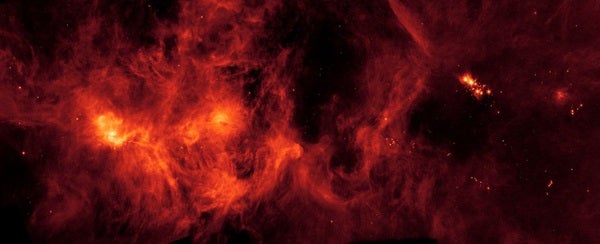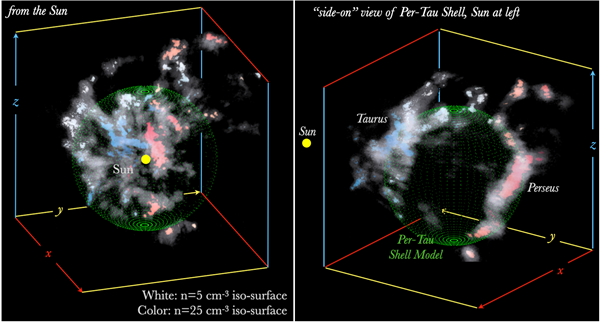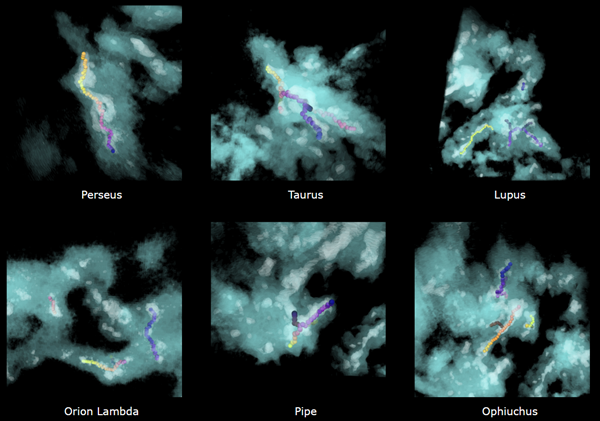About a dozen stellar nurseries reside in the solar neighborhood. Perhaps the most thoroughly studied among them are Taurus and Perseus molecular clouds. Countless celestial cartographers have scrutinized the two regions, filling their maps with stars and vast clouds of gas intertwined with dark, dusty lanes.
But such maps, however beautiful and informative, lacked a crucial piece of the puzzle: the third dimension, distance. Without knowing the distances to these star-forming molecular clouds, astronomers could not unravel their true shape in space — until now.
In a new study published September 2 in The Astrophysical Journal Letters, astronomers explored a recently created 3D dust map of our solar neighborhood. Using it, they discovered that the Taurus and Perseus star-forming regions are both separate parts of a larger shell of compressed gas. According to the researchers, it seems that a series of supernova explosions pushed material into the shell, initiating the formation of new stars.
Making a 3D map
Scientists have been studying the 2D projections of Taurus and Perseus in the sky for a century. But how do they make the jump to 3D?
Dust constitutes only a small percentage of the mass of a star-forming cloud. However, it happens to be an excellent tracer of the dominant molecular gas from which stars are born. That’s why, in the new study, astronomers examined the Taurus and Perseus star-forming regions in 3D dust maps published in 2020 by co-author Reimar Leike and collaborators from the Max Planck Institute for Astrophysics in Germany. The maps extend to a distance of 1,300 light-years from the Sun and show details down to features just over 3 light-years in size.
To make such a map, Leike’s team collected information about roughly 5 million stars in the solar neighborhood. They used the stars’ colors, which can be affected by dust sitting between Earth and the stars, to determine how much dust lies in different directions. They then combined this information with accurate distances to the stars, provided by the European Space Agency’s revolutionary Gaia spacecraft.
“Prior to the launch of the Gaia space observatory, we typically knew where star-forming regions are located in a galaxy to the accuracy of 20 to 30 percent, which is a huge [margin of error],” says Catherine Zucker, a postdoc fellow at the Center for Astrophysics | Harvard & Smithsonian in Cambridge, Massachusetts, and a co-author of the new study. “With Gaia, our distance precision increased by a factor of five.”
Now, Zucker and her collaborators finally got to look at the clouds’ true forms — and they were in for a surprise.
Supernovae and star births
In 2D projections, Taurus and Perseus appear connected by a smooth bridge of material. However, the 3D map revealed they are, in fact, physically separated clouds. Furthermore, both seem to be parts of a near-spherical shell with a radius of about 245 light-years.
Furthermore, the team’s inspection of various images of the region taken at different wavelengths revealed the clouds represent the aftermath of several supernovae that exploded in the central part of the shell in the last 6 million to 22 million years. The blasts rippled outward, compressing gas and dust and creating the conditions necessary to form new stars.
Indeed, astronomers know that supernovae explosions are one of the main regulators of star formation in the Milky Way. “They trigger star formation locally at specific places, while globally they help to suppress star formation,” says Munan Gong, a postdoctoral researcher at Max Planck Institute for Extraterrestrial Physics in Germany, who wasn’t involved in the study. The Perseus-Taurus complex now offers the first 3D observational view of the results of this complex process.
Gong, who simulates star formation in such clouds, looks forward to getting her hands on the 3D maps and compare them to her simulations. So far, she says, astronomers have only looked at how supernovae affect average star-formation properties, such as the rate of star formation or the density of material in such clouds. “But the 3D dust map really allows us to look at the structure,” she says.
Uncovering a reason for being
This analysis of Taurus and Perseus molecular clouds is just the first look at the new 3D maps. In a companion paper published in The Astrophysical Journal, Zucker and collaborators also looked at the general 3D properties of 12 total star-forming regions. A thorough ongoing analysis will show whether shells like those formed by Taurus and Perseus exist elsewhere.
The maps will continue to get better as the precision of Gaia’s distance measurements improve as well. But mapping is only the first step. “The next frontier, beyond just having three spatial dimensions, is also having three dimensions of motion,” says Zucker.
Gaia, aided by telescopes on Earth, also shows how stars are moving through the galaxy. Astronomers can take this present-day snapshot and, knowing how gravity in the Milky Way affects its stars, trace back where these objects were 10 million years in the past or where they will be 10 million years in the future. With this information, astronomers can start to construct a detailed history of star formation in the local universe.
And that will give researchers the insight they’d desperately like into how such clouds, which shape the galaxies around them, spring up in the first place. As study co-author of Robert Benjamin of University of Wisconsin (Whitewater) tweeted: “I’m beginning to wonder if every molecular cloud needs to have a Reason for Being; that is, they don’t just form randomly.”












